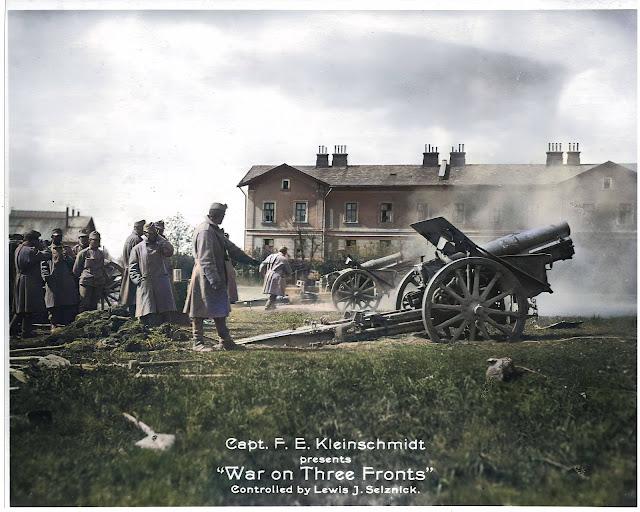Big game hunter, Arctic explorer, writer, lecturer and cinematographer Captain Frank E. Kleinschmidt (1871-1949) deserves a special place in World War I film history. He was in 1915 the only neutral American cameraman to film a submarine in action and fly above the Balkan front, taking motion pictures of the attack by the Central Powers on the Serbian capital, Belgrade. Kleinschmidt’s camera also recorded some stunning scenes of actual fighting in the trenches on the eastern front, which were retrieved and described in our latest book, American Cinematographers in the Great War
 |
Publicity scenes from Kleinschmidt's film War on Three Fronts |
Tantalizing New Information
Since we published this book, some tantalizing new pieces of information on Frank Kleinschmidt's World War I movie adventures have been found. On June 2, 2014, the Austrian government opened the exhibition Extra Ausgabee! on the k.u.k. Kriegspressequartier, the Austro-Hungarian military press office during World War I. Kleinschmidt was attached to this press office as an accredited war reporter between February-December 1915. Among the many interesting photographs presented at this exhibition in Vienna was a picture showing Kleinschmidt cranking a movie camera in the company of a squad of Austro-Hungarian soldiers. The caption - translated into English - says: "The American film operator Captain Frank E. Kleinschmidt, with the 32. Lft. Infantry Regiment in the trenches."Das 32. Lft. Inf. Reg. im Schutzengraben, der U.S.-Filmoperateur Captain Frank E. Kleinschmidt. Colorized picture from www.twitter.com/extraausgabee |
Scenes showing Kleinschmidt at work while filming the Great War are rare, and while extremely fascinating this picture does present some problems. The photograph was taken from the backside of the trench, presumably at a great risk for the cameraman because he must have exposed himself as a target for the enemy. Judging from the easy-going behaviour of the soldiers, the scene probably was shot somewhere behind the actual firing lines for the purpose of getting a good picture. The caption is puzzling. The 32th K.u.K. Infantry Regiment was an Hungarian unit, based at Trieste near the Adriatic Sea. This fits in with Kleinschmidt's work at the military press office. From November 6, 1915, he was attached to the staff of the 16th Army Corps at Trieste. Apart from filming Austrian mine sweeping activities, Kleinschmidt covered an air raid on the Italian coast from the Trieste frontline. However, the Austrians had no such military unit as a "Lft. Inf. Reg.". "Lft." was short for Luftfahrtruppe, the Austrian World War I airforce. Perhaps this specific picture was taken with the assistance of a detachment of airforce soldiers based near Trieste.
 |
Frank E. Kleinschmidt in Austrian airforce uniform. Studio portrait early 1915. Courtesy Ruth Sarrett.Link to high res image |
Incorporated into Hollywood Legend
The collection of the Austrian World War I exhibition also
revealed a remarkable picture taken by Kleinschmidt in
Galicia, during the 1915 Austro-German offensive on the eastern front in Russian
Poland. This picture was reproduced in our latest book as a publicity
shot for his film War on Three Fronts.
The presentation at Vienna showed that Kleinschmidt's photograph was also published
in the Austrian press, presumably because he was part of an official Austro-Hungarian photographic unit. The picture appeared on July 15, 1915 in the Weltspiegel and shows Austrian gunners
manning a 15-centimeter battery of artillery. This scene later became
part of Hollywood legend and history, because it was bought by director D.W. Griffith
when he was working on his World War I drama Hearts of the World (1918) with actresses Lilian and Dorothy
Gish and his cameraman Billy Bitzer. In Griffith's version the Austrians were
introduced as brutal German soldiers threatening a peaceful French village.
Clearly, several liberties were taken by Griffith with historical events. Kleinschmidt,
as we found out during our research, was very much disappointed Griffith hadn't
used more of his war film. He also offered his services to Griffith as an actor and military advisor for any possible upcoming new war films.
Austrian artillery in action on the Eastern Font. Colorized publicity picture from Kleinschmidt's film. |
The Austrian exhibition on the military press office during World War I closed on October 31, 2014, but on Twitter many fascinating pictures can still be viewed at www.twitter.com/extraausgabee
The exhibition is particularly interesting because of the attention it gives to the way the Austro-Hungarian government used modern pictorial media such as films for wartime propaganda purposes. In this respect the Dual Monarchy was - compared to the Germans as well as the Entente - clearly open to a more modern approach.



No comments:
Post a Comment
Note: Only a member of this blog may post a comment.